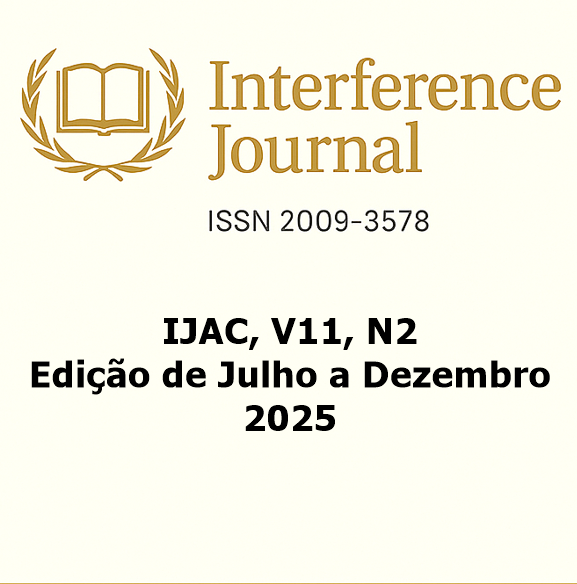O Impacto da Pedagogia Lúdico-Afetiva no Desenvolvimento Infantil
DOI:
https://doi.org/10.36557/2009-3578.2022v11n2p128-144Palavras-chave:
Pedagogia lúdica, Vínculo afetivo, Desenvolvimento infantil, Aprendizagem interativa.Resumo
Este artigo investiga a relevância da pedagogia lúdico-afetiva no desenvolvimento infantil, destacando práticas que fortalecem vínculos emocionais e potencializam a aprendizagem entre professores e alunos. A proposta se insere num contexto educacional que busca ambientes mais inclusivos, acolhedores e significativos, onde o afeto e a ludicidade atuam como pilares transformadores do processo de ensino. O objetivo principal é analisar como atividades lúdicas, quando aliadas à afetividade, estimulam a criatividade, autonomia e o desenvolvimento socioemocional das crianças. Além disso, busca-se compreender como essas práticas influenciam positivamente a construção de relações interpessoais mais saudáveis e a formação de um ambiente escolar baseado na empatia e na cooperação. A metodologia adotada fundamenta-se em uma revisão bibliográfica que contempla contribuições de nove autores brasileiros contemporâneos. Esses estudos abordam os impactos da ludicidade e do afeto na aprendizagem, discutindo seus efeitos sobre o engajamento dos alunos e sua atuação na transformação da prática docente. A análise crítica se concentra na reflexão sobre os benefícios e limitações dessa abordagem, considerando os desafios enfrentados por educadores na sua implementação efetiva. Como conclusão, o artigo aponta que a pedagogia lúdico-afetiva representa uma estratégia eficaz para promover o desenvolvimento integral da criança e fortalecer o vínculo entre aluno e professor. Ao reconhecer o valor do afeto e do brincar como elementos centrais na educação, reforça-se a necessidade de práticas mais humanizadas, capazes de gerar impactos duradouros na formação de indivíduos sensíveis, autônomos e socialmente comprometidos. A adoção de tais práticas, além de inovar o fazer pedagógico, contribui para um projeto educacional mais justo, inclusivo e significativo.
Downloads
Referências
CANDAU, V. M. Práticas pedagógicas inclusivas: desafios e possibilidades. Educação e Pesquisa, São Paulo, v. 47, 2021, p. 1-15.
CUNHA, C. Formação de professores e o uso do lúdico na sala de aula: desafios e perspectivas. Revista Brasileira de Educação, Rio de Janeiro, v. 28, e280020, 2023.
DAVIS, C. Ludicidade e desenvolvimento socioemocional: abordagens psicopedagógicas. In: OLIVEIRA, Z. M.; AMORIM, L. (orgs.). Psicologia na educação básica. Campinas: Papirus, 2022, p. 125-140.
FARIA, A. L. G. Infância e brincadeira: um estudo sobre o desenvolvimento social e afetivo na educação infantil. Cadernos de Pesquisa, São Paulo, v. 50, n. 176, 2020, p. 255-270.
FERNÁNDEZ, A. Psicopedagogia e o papel do afeto no desenvolvimento infantil. In:
REYES, M. S.; SALLES, A. (orgs.). Práticas psicopedagógicas na infância. Porto Alegre: Artmed, 2021, p. 89-105.
GATTI, B. A. Formação de professores para uma prática pedagógica inclusiva e afetiva. Educação e Sociedade, Campinas, v. 42, e022343, 2021.
MACEDO, L. O brincar e o aprender: perspectivas para o desenvolvimento infantil. Psicologia Escolar e Educacional, São Paulo, v. 26, e221374, 2022.
MACHADO, N. J. Ética e ludicidade na educação: reflexões sobre a prática pedagógica. Revista Brasileira de Educação, Rio de Janeiro, v. 27, e270123, 2022.
PACHECO, J. Educação em rede: a importância do afeto e da ludicidade nas práticas educativas. In: COSTA, M. L.; REZENDE, C. F. (orgs.). Educação e transformação social. Belo Horizonte: Autêntica, 2020, p. 45-60.
Downloads
Publicado
Como Citar
Edição
Seção
Licença
Copyright (c) 2025 José Carlos Guimarães Junior, Fabiano Da Silva Araujo, Marttem Costa de Santana, Hilke Carlayle de Medeiros Costa, Girlandio Pedro Dantas, Sávio Lima da Costa e Silva, Mario Junior Saviato

Este trabalho está licenciado sob uma licença Creative Commons Attribution 4.0 International License.
Você tem o direito de:
- Compartilhar — copiar e redistribuir o material em qualquer suporte ou formato para qualquer fim, mesmo que comercial.
- Adaptar — remixar, transformar, e criar a partir do material para qualquer fim, mesmo que comercial.
De acordo com os termos seguintes:
- Atribuição — Você deve dar o crédito apropriado , prover um link para a licença e indicar se mudanças foram feitas . Você deve fazê-lo em qualquer circunstância razoável, mas de nenhuma maneira que sugira que o licenciante apoia você ou o seu uso.
- Sem restrições adicionais — Você não pode aplicar termos jurídicos ou medidas de caráter tecnológico que restrinjam legalmente outros de fazerem algo que a licença permita.


